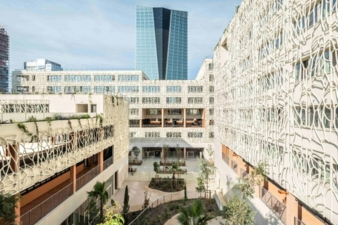07.01.25 – Lightweight construction
Flax composite for shading an international school building
In a collaborative effort, Bcomp’s innovative flax fibre composites and Temca’s manufacturing expertise have been combined to create the cladding panels for the facade of the new Cité Scolaire Internationale Jacques Chirac in Marseille, France.
Designed by Rudy Ricciotti and manufactured by Temca for general contractor Bouygues Bâtiment Sud-Est (BBSE), the shade-providing panels are assembled into a beautiful decorative trellis that clads 5,000m² of the school building. The trellis is made of 880 openwork panels, using five different moulded shapes arranged to achieve energy efficiency by adapting shading to sunlight exposure, while maintaining a unique building design. Almost 8000m² of “ampliTex” technical fabric are used, making it the biggest architectural project to date featuring Bcomp’s bio-composites.
A building that exemplifies sustainable architecture and design
The panels were manufactured using the resin transfer moulding process, with polyester resin reinforced with glass fibre and Bcomp’s “ampliTex” material. The panels are coated with a white gel coat formulated to withstand exposure to outdoor elements like UV rays, rain, and pollution. The composite also meets fire requirement specifications.
The cladding offers numerous benefits in addition to its gorgeous, nature-inspired aesthetic, which is visible from both classrooms and street level. The panels were designed and carefully placed in positions on the building’s facade to obscure the unique levels of heat and glare in specific locations. Consequently, they will play an important role in keeping interior spaces cooler and reducing energy demands to improve the building’s environmental footprint. The integration of flax fibres in the composites used for the panels also reduces the weight of the openwork cladding. Weighing between 18 and 37 kg each, the panels are mounted to the building’s exterior using stainless steel inserts bonded with structural adhesives, light weighting the facade relative to standard materials like concrete.

